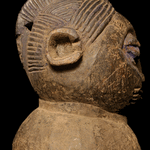Yoruba Gelede Mask, 1850 CE - 1920 CE
Wood/Pigment
12
DA.415 (LSO)
Further images
This beautifully patinated anthropomorphic mask was made by the Yoruba people of Nigeria. It displays both traditional and unusual characteristics. The structure is fairly typical, with a domed base –...
This beautifully patinated anthropomorphic mask was made by the Yoruba people of Nigeria. It displays both traditional and unusual characteristics. The structure is fairly typical, with a domed base – which was worn atop the head – and a ring encircling the construction (or neck) between the base and the head. The head is broad and deep, with strong jowls, a slim, domed brow and a crested coiffure that projects posteriorly with cup-shaped, back-set ears. The face is somewhat lugubrious, with deep hollows beneath the brows and set into the cheeks, hooded eyes, a long trilobate nose and set lips running in direct parallel. The cheeks are marked with two sets of horizontal scars set side-by-side. The patina is absolutely outstanding, and suggests long usage. The eyes are highlighted with Reckitt’s Blue, a laundry dye that was introduced to Nigeria by colonials, and which was extensively used in artworks as an act of reverence (this colour is considered to be sacred). The texture of the carving suggests that it may have been re-done over time, making this a highly significant mask.
The Yoruba are a Central Nigerian tribal group, originally descended from a Hausa migration from the northeast in about 900 AD. A small kingdom – Ile Ife – was founded by Oduduwa, followed by great sociopolitical expansion into Southwest Nigeria, Benin, and Togo. The influence of the city was felt far beyond these boundaries, however, and many smaller political entities were held under its sway. Communities were presided over by the Oba (king) and various senates (Ogboni), and councils made up of guild leaders, merchants and the lesser aristocracy (related to the Oba). The Yoruba have an exceptionally rich and diverse mythology, history and religious context, all of which are directly linked to their artistic output; in Yoruba society, this grouped heritage is known as the Itan.
This mask is intimately associated with rituals performed by men’s societies bent upon the protection of the living. Specifically, Gelede is intended to honour the spiritual aspects of femininity, and to prevent this from becoming destructive to the society to which they belong. Angered female spirits (Aje) may destroy entire communities; for this reason, they are placated by dancing performances so that their power is directed towards the benefits of the group. Each village and area had distinctive patterns of Gelede masks that reflect some facet of their social organisation or mythology. The well-worn holes around the perimeter of the rim indicate that it originally worn with a large cloth costume that would have covered the masquerade dancer and concealed their identity. As it is a forehead mask, there are no eyeholes.
It is possible that further research could determine more about this piece. However, whatever its specific origin, it is a remarkably well-rendered and patinated piece that would grace any collection or sophisticated domestic setting.
The Yoruba are a Central Nigerian tribal group, originally descended from a Hausa migration from the northeast in about 900 AD. A small kingdom – Ile Ife – was founded by Oduduwa, followed by great sociopolitical expansion into Southwest Nigeria, Benin, and Togo. The influence of the city was felt far beyond these boundaries, however, and many smaller political entities were held under its sway. Communities were presided over by the Oba (king) and various senates (Ogboni), and councils made up of guild leaders, merchants and the lesser aristocracy (related to the Oba). The Yoruba have an exceptionally rich and diverse mythology, history and religious context, all of which are directly linked to their artistic output; in Yoruba society, this grouped heritage is known as the Itan.
This mask is intimately associated with rituals performed by men’s societies bent upon the protection of the living. Specifically, Gelede is intended to honour the spiritual aspects of femininity, and to prevent this from becoming destructive to the society to which they belong. Angered female spirits (Aje) may destroy entire communities; for this reason, they are placated by dancing performances so that their power is directed towards the benefits of the group. Each village and area had distinctive patterns of Gelede masks that reflect some facet of their social organisation or mythology. The well-worn holes around the perimeter of the rim indicate that it originally worn with a large cloth costume that would have covered the masquerade dancer and concealed their identity. As it is a forehead mask, there are no eyeholes.
It is possible that further research could determine more about this piece. However, whatever its specific origin, it is a remarkably well-rendered and patinated piece that would grace any collection or sophisticated domestic setting.
14
of
14





